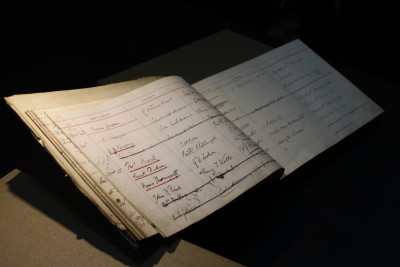
Basil Beattie RA, Never Before, 2001.
Oil and wax on flax. 2540 mm x 3048 mm x 76 mm. © Basil Beattie RA. © Photo: Royal Academy of Arts, London. Photographer: John Hammond.
This image is not available to download. To licence this image for commercial purposes, contact our Picture Library at picturelibrary@royalacademy.org.uk
Never Before, 2001
Basil Beattie RA (b. 1935)
RA Collection: Art
Basil Beattie is both a painter and printmaker who first trained at West Hartlepool College of Art from 1950 to 1955 and then at the Royal Academy Schools. At art school he was influenced by the work of Walter Richard Sickert and his early work reflected this with subjects of ordinary people working and at leisure. In 1958, however, a Tate Gallery show of New American Painting, which included work by Mark Rothko, Jackson Pollock and Sam Francis, proved a liberating experience for the development of his work. Other students at the Royal Academy Schools such as John Hoyland and Paul Huxley also shared his enthusiasm for the work of the Abstract Expressionists.
Although the influence of these American painters was strong, Beattie's work continued to make reference to the visible world. From the 1980s this often took the form of spatial components such as steps, doors, tunnels or shapes which resembled ziggurats, the ancient temple towers built up in successive stages. These paintings explored abstract pictorial spaces and the associated feelings that they engendered.
Beattie himself does not make a distinction between abstraction and representation: 'My paintings are abstract to me, but I feel I can put almost anything in. I put things that have references to psychological and emotional concerns that are important to me; but I'm trying to paint them in a way that is not illustrative. I'm fascinated by the representational element - it gives me large and small, a sense of distance. There's intrigue, as well: the curiosity of corridors, colonnades, archways, cloisters. But I withdraw from describing it to myself in a precise way because I want it to remain ambiguous. Perhaps an image - a door or whatever - may invite thoughts of escape; but the sheer physicality of the means prevents there being an escape from the language of painting. I deliberately construct this contradiction.' (Conversation with John McEwen 1988, published in exhibition catalogue, Basil Beattie, Todd Gallery, London 1998)
Never Before suggests a narrative of ascent with its stairs, but these lead nowhere, not even to the top of the canvas. Beattie has said that he often thinks of them symbolically 'as stages of endeavour through life.' The 'stairs' are painted with the thick impasto, in a subdued range of earth colours, which contrasts with the bare flax support which Beattie often refers to as a breathing space or 'lung'.
Object details
2540 mm x 3048 mm x 76 mm
Start exploring the RA Collection
- Explore art works, paint-smeared palettes, scribbled letters and more...
- Artists and architects have run the RA for 250 years.
Our Collection is a record of them.



